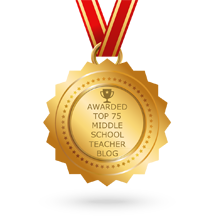So we started off gathering together on the rug. I had the easel next to me and some markers and chart paper. I told the kids our objective, that today we're going to decide if books are Vacation (too easy) JR, or Future (too hard) books. We composed a chart together:
and then I had them pick two books from a few boxes of books I had available. We decided to read for five minutes the first session, at which time I would call them back for a "Check-In."
Couple of issues came up in the first five minutes:
1. I left all the boxes of books scattered around the carpet, so when they would need to switch, they were distracting one another by stepping over each other. For the second session, I got the books out of the way and put them in another area of the room, which worked much better.
2. I have an armchair and another little chair in my room - I prompted them before we started that we can't argue about the chairs and things like that, and they didn't. They were so quiet about it and respectful, but these two chairs still led to time off task, so in the future, I would have to assign them to two people just to take away the calling seat-backs and saving the chair for friends situation. Again, they were great kids, but they are kids and don't realize the very most important thing is to be engaged as long as possible.
Okay, anyways....
We meet back together as a whole group for check-in. I reminded them what each of the three kinds of books were - Vacation, JR, and Future. I then asked if anyone was reading a Vacation book. A few kids raised their hands and I had them come up to guide them through an explanation of why the book was a vacation book. Then we did the same for Future books, and finally we talked about JR books again. This conversation is so important for all the kids to hear, so they not only learn about what these three kinds of books are, but they also think about the book they are reading to decide if it's JR. This is essentially a teacher think-aloud, but with the child's thinking!
We decided to do another session of reading - this time, 7 minutes (their other objective was to build their stamina), so they went back, maybe traded books, and then went to get to reading. I reminded them of their objective once again - to figure out if their book is a Vacation, JR, or Future book as they read.
We also talked briefly about how Reading is Thinking, so if we have to move around the room for a new book, we should be doing it soo soo quietly as to not disturb our peers.
Our seven minutes wrapped up - and the on-taskness (making up words: love!) was much better with the books in another place. Kids remembered to be quietly move around the room and they did great for seven minutes.
This time rather than sharing in a group, I wanted individual information on each child and their book, so I modeled this exit slip, one part at a time:
The hardest part was the Why? part, which I had two kids explain their answers to me and I wrote their why answer for them, showing all the others.
Here are two exit slips I collected:
And....
We wrapped up and that was that!
Here's what I learned:
- This mini-lesson works in seventh and eighth grade, all the way down to second. First and Kinder - ehhhh....not sure yet!
- This lesson is actually easier with second graders - they really want to find the book that is JR, and they don't have as much social pressure (like a 7th grader would) to read a certain kind of book.
- This isn't the end of the lesson(s) with Vacation, JR, and Future books. I need to do more with this lesson - add more descriptors to the chart, have more sessions for kids to read and think about what kind of book it is, and more time for kids to share and evaluate their book choices. Little kids need lots of practice with this, and this is a conversation that will keep coming up all year long!
Centers vs. Independent Reading
Centers take so long to plan, prepare, and set up. It's the teacher who has to do all the work for the centers, because they have to be changed often. This is why I love independent reading (or listening to reading on tape, or buddy reading) so much more. It's less work for the teacher and it's more time with books and reading for the kids. I'd much rather have kiddos doing authentic, purposeful reading - volumes and volumes of reading - than stressing myself out planning 100 centers for the year!
Of course, there are times when you do need some kinds of literacy centers to build up the prerequisite skills to reading a book, but once they become independent with reading, and with the exception of some remediation for various aspects of their reading, independent reading is the way to go!
What do you think? Any suggestions for getting independent reading off the ground with primary kids? Please share your tips and tricks!
Until next time,
































0 comments:
Post a Comment